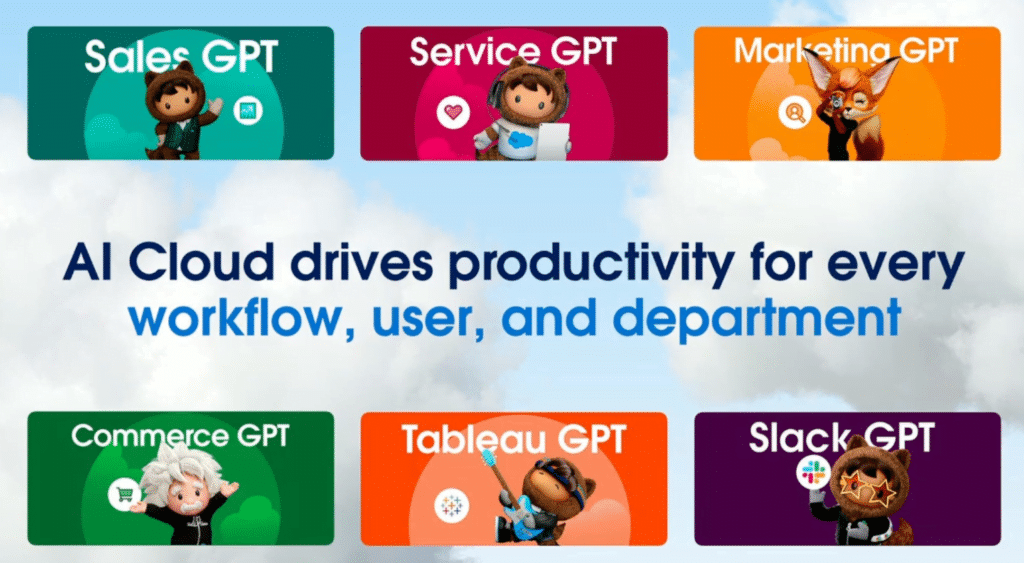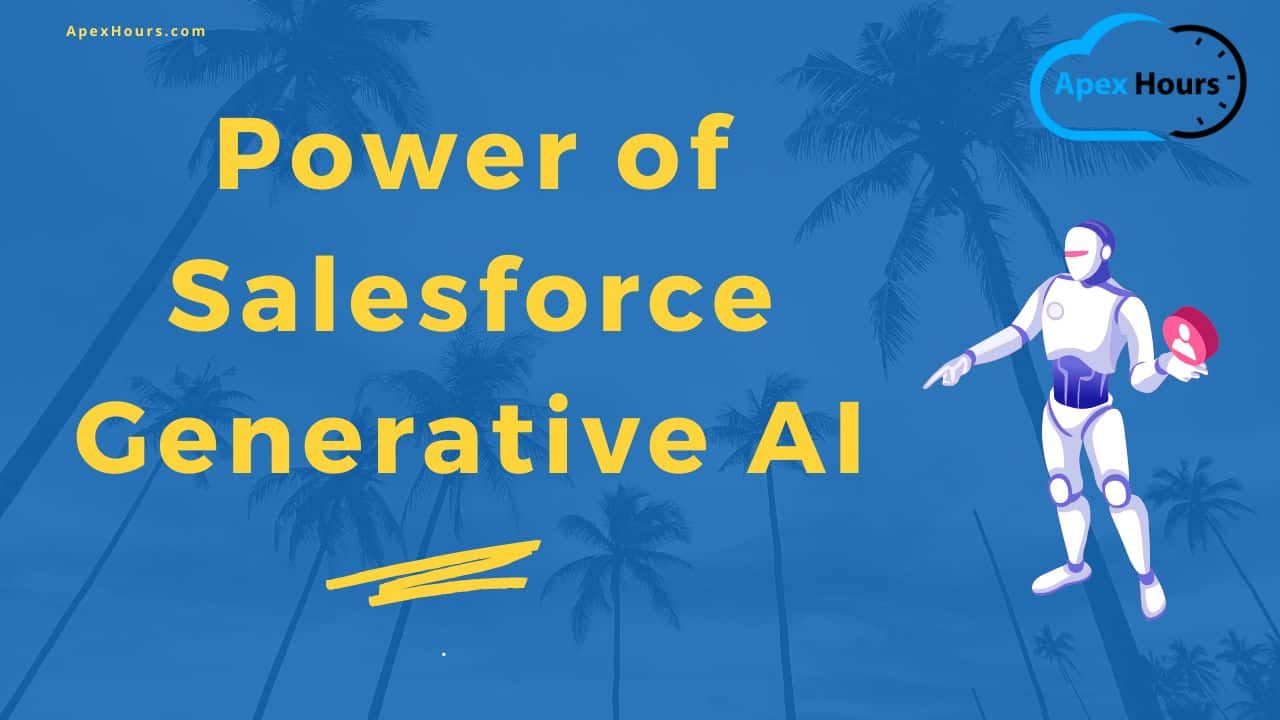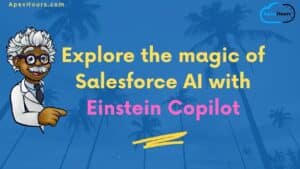There is significant buzz around the word “Generative AI,” so today, we will be on the trending topic of the technology Generative AI of the salesforce. Generative AI (genAI) is a type of artificial intelligence (AI) that can create new content. It learns patterns from training data and generates new outputs with similar statistical properties. Join us to Unleash the power of Salesforce Generative AI.
What is Generative AI?
So, Generative AI is a kind of AI that generates output from the input provided to it by the user. The Generative AI learns on its own, to be more precise; for example, if a user is providing input that “give me the image of the cat or generate the image of the cat,” at that time, the AI will go through stuff and all the images of the cats around and based on that it will create new cat image for you and also it will add all the features according to user’s requirement.
Also, Generative AI updates itself from the feedback you provided. For example, if you ask AI to generate an image of a cat, and the picture given in the output doesn’t look like a cat, and you provide specific feedback for that, it will learn from your feedback and update its output better than the previous one.
How exactly does generative AI work in the very next slide? But before that, this was the simple concept of Salesforce Generative AI.
Some examples of generative AI include:
- GPT-3: A language generation model developed by OpenAI that can create human-like text
- Generative Adversarial Networks (GANs): A machine learning model that consists of two neural networks
- Variational autoencoders (VAEs): Encodes data into a lower-dimensional representation and then decode it back into the original format
- Generative AI uses machine learning techniques, such as Deep learning, Neural networks, GANs, VAEs, and LLMs.
- Generative AI is used in tasks such as Image synthesis, Text generation, and Video prediction.
- Generative AI is different from adaptive AI, which focuses on learning and adapting from data to enhance decision-making and process optimization.
Basics of AI
So here’s how Generative AI works, basically, the two main aspects where we need to focus are Generative Adversarial Networks (GANs) and Variational Autoencoders (VAEs).
So, GANs comprise two factors, which are the generator and discriminator. The generator generates the output, and the discriminator gives feedback to that output. In the previous example of the image generation of the cat, the generator generates the images of the cat, and the discriminator keeps on rejecting those images until it has the perfect output of the cat’s image.
In a nutshell, the Generator generates the image but won’t present it to the user until the discriminator says it is perfect. Discriminator: It constantly gives feedback to the generator, and when the satisfactory output comes, it will give positive feedback to the generator then the generator will show the output to the user.
Variational Autoencoders (VAES)
So VAEs or Variational Autoencoders are comprised of two factors, which are the encoder and decoder. The encoder collects big data from everywhere and compress it into smaller part, and the decoder will reverse the process.
Again, with the example of the cat, when the user asks AI to generate an image of the cat, it will collect the data of all images of the cat out there and compress it into smaller parts and then, according to the user’s requirement, it will generate the image of the cat by its own.
So again to make it simple,
- Encoder: it will collect the big data and compress it
- Bottleneck: this is the point where the encoder and decoder meet
- Decoder: it will provide the data according to the user’s requirement.
Is AI the new concept?
No, the AI is not a new concept, earlier the definition of the AI was somewhat different from the current Generative AI. Now we already have the Generative AI the concept of the AI that have been use previously is known as the traditional AI.
Traditional AI is the pre-programed language which reacts according to its training and algorithms. This does not have the capability to learn new things basses on the feedback and input provided to it.
So all and all, Traditional AI follows pre-defined knowledge, rules and patterns. It performs tasks based on the pre-defined logic. Also it requires human effort and explicit programming.
In a conclusion, AI is not a new concept for sure but the term Generative AI is new. The new approach of the AI is Generative AI. Which has so many extended features which Traditional AI did not have.
Has Salesforce Use it recently?
Well again, the word AI is not a new concept for Salesforce too. The evolution of AI in Salesforce has been marked by a progression of features and capabilities aimed at enhancing user experiences, automating tasks, and providing more intelligent insights within the Salesforce platform. Here’s a general overview of the evolution of AI in Salesforce:
1. Salesforce Einstein (2016)
Salesforce introduced Einstein, an AI-powered feature set across its various Clouds (Sales Cloud, Service Cloud, Marketing Cloud, etc.). Einstein included capabilities such as predictive lead scoring, automated email responses, and predictive analytics to help users make data-driven decisions.
2. Einstein Vision (2017)
Einstein Vision was introduced to bring image recognition capabilities to Salesforce. It enabled users to build and train custom image recognition models for tasks like identifying products or objects within images.
3. Einstein Voice (2018)
Salesforce introduced Einstein Voice, leveraging natural language processing (NLP) for voice commands and transcriptions. This allowed users to interact with Salesforce using voice commands and receive insights through natural language interactions.
4. Integration with IBM Watson (2018)
Salesforce collaborated with IBM Watson to integrate advanced AI capabilities into its offerings. This partnership aimed to enhance customer relationship management (CRM) by leveraging IBM’s Watson for deeper insights and cognitive analytics.
5. Einstein Bots (2018)
Einstein Bots were introduced to automate routine customer interactions using chatbots. These bots could handle common queries, freeing up human agents to focus on more complex tasks.
6. Acquisition of Tableau (2019)
While not directly an AI feature, Salesforce’s acquisition of Tableau in 2019 strengthened its analytics capabilities. Tableau’s advanced analytics and visualization tools complemented Salesforce’s AI offerings, providing users with powerful insights.
7. Einstein Analytics (2020)
Salesforce introduced updates to Einstein Analytics, bringing more sophisticated analytics and machine learning capabilities to help users uncover insights, predict outcomes, and make smarter decisions.
8. Hyperforce (2020)
Salesforce’s Hyperforce initiative, while not AI-specific, emphasizes the importance of cloud infrastructure in supporting AI and machine learning workloads at scale.
9. Einstein Automate (2021)
Salesforce announced Einstein Automate, a set of tools and services aimed at automating workflows and business processes. It includes capabilities such as Flow Orchestrator and MuleSoft Composer for no-code and low-code automation.
10. Incorporation of External AI Solutions
Salesforce has also encouraged the integration of external AI solutions through its AppExchange marketplace, allowing users to leverage third-party AI technologies seamlessly within the Salesforce environment.
Learn how you can integrate ChatGPT with Salesforce.
How Generative AI Enhances Salesforce Utility
Here is How Generative AI Enhances Salesforce Utility.
1. Automated Data Entry and Cleansing
Generative models can be trained to identify anomalies or outliers in the data. This is particularly useful for detecting and correcting errors or inconsistencies in Salesforce databases.
Generative algorithms can help standardize data formats, units, or naming conventions, ensuring consistency across different datasets. By understanding patterns and relationships in the data, generative AI can assist in identifying and resolving duplicate records in Salesforce.
2. Customer interaction:
Generative AI-powered chatbots enable businesses to provide round-the-clock customer support. Customers can get instant responses to their queries, even outside regular business hours.
Generative models with NLP capabilities can understand the intent behind customer queries, allowing for more accurate and context-aware responses. Generative AI can analyse customer data to provide personalized product or service recommendations based on individual preferences and behaviour.
3. Personalized marketing content:
Generative models can dynamically generate content variations based on customer data, preferences, and behaviour. This enables marketers to create personalized messages, emails, or advertisements for different segments of their audience.
Generative AI can be used to personalize email content dynamically. It can tailor subject lines, body text, and call-to-action buttons based on the recipient’s preferences, past interactions, and demographics.
4. Automated report generation:
Generative AI can analyse large datasets, identify patterns, and extract meaningful insights. This can help in automatically generating reports that highlight key trends, anomalies, and actionable insights.
5. Lead generation and segmentation:
Generative models with NLP capabilities can analyze email interactions and chat conversations to assess lead intent and qualification. This helps in determining whether a lead is ready for further engagement.
6. Predictive analytics for sales forecasting:
Generative AI can incorporate external data sources, such as economic indicators, industry trends, or market conditions, to improve the accuracy of sales forecasts by considering broader contextual factors.
7. Dynamic pricing optimization:
Dynamic pricing indication involves adjusting prices in real-time based on various factors such as demand, supply, competitor pricing, customer behaviour, and market conditions. Generative AI can be beneficial in providing insights and indications for dynamic pricing strategies.
8. Enhance image recognition for visual data:
To make image recognition better, use advanced methods like deep learning with convolutional neural networks (CNNs), consider techniques such as data augmentation and attention mechanisms, and explore real-time detection models like Single Shot Multibook Detector (SSD). Additionally, improve interpretability with explainable AI, adapt to new data with continual learning, and consider hardware acceleration like GPUs for faster processing.
Data Types that Generative AI can generate
Here are Data Type that GEN API can generate.
Text
- ChatGPT (by OpenAI): Description: A sibling model to GPT-3, ChatGPT is designed specifically for conversational interactions. It can be used to build chatbots, answer user queries, and engage in natural language conversations. Use Cases: Customer support, virtual assistants, chat applications.
- Google’s BERT (Bidirectional Encoder Representations from Transformers): Description: BERT, developed by Google, is designed for natural language understanding. While not a text-generation tool per se, it has been used in various applications, including text completion and sentence-generation tasks. Use Cases: Question answering, sentiment analysis, text completion.
Images
Midjourney is a self-funded, closed-source program that uses language and diffusion models to generate images. It’s considered one of the easiest AI image generators to use. For example, a basic prompt like “a cow” can produce good results.
Video
- RunwayML: RunwayML offers various AI models for creative applications, including video. It provides tools for generating and manipulating videos using machine-learning models.
- Deep Dream Generator: Deep Dream Generator applies neural networks to images and videos, creating visually unique and surreal effects. It’s based on the DeepDream algorithm developed by Google.
Audio
- WaveNet by DeepMind: WaveNet is a deep generative model for audio synthesis developed by DeepMind. It’s known for its ability to produce high-quality and realistic human-like speech.
- Lyrebird: Lyrebird is a voice synthesis platform that uses deep learning to create realistic-sounding voice replicas. Users can create custom voice recordings based on a provided audio sample.
3D models
- DeepDream3D: DeepDream3D applies deep neural networks to generate 3D models from 2D images. It’s particularly known for its ability to transform everyday scenes into surreal and dreamlike 3D environments.
- GANPaint Studio: Developed by MIT-IBM Watson AI Lab, GANPaint Studio allows users to interactively modify images and generate 3D scenes by adding or removing specific features. It’s based on generative adversarial networks (GANs).
Salesforce symphony of GPTs
Showing some real examples of how we can use generative AI in Salesforce:

Einstein GPT
Imagine Einstein GPT as a super-smart assistant that helps people using Salesforce (a business tool). It uses two kinds of brains:
1. Salesforce’s Smart Brain: This is like the secret sauce made by Salesforce. It helps the assistant understand and work with your company’s information in Salesforce.
2. OpenAI’s ChatGPT Brain: Thanks to a friendship between Salesforce and OpenAI, the assistant also has a super cool brain from OpenAI. This brain is great at understanding and talking in a way that feels natural, like chatting with a helpful friend.
3. Your Own Special Brain: If you have your own super-secret brain (model), Einstein GPT is cool with that too! It can work alongside your special brain to make things even more awesome.
So, when you ask these assistant questions in simple language, it uses all these brains to give you really smart and customized answers, saving you a lot of time. It’s like having a genius helper in your computer!
Learn more about Salesforce Einstein GPT. Learn about Einstein for Developers.
Sales GPT
Imagine you have a super tool that makes your website not just a site but a lead-catching wizard. It doesn’t stop there – it checks out the leads and hands them over to the right people in a flash. Plus, it’s a pro at crafting emails that feel like they were written just for you. And guess what? It’s not just for you; it helps your whole team stay on the same page and gives them tips to be even better at what they do. It’s like having a team of superheroes for your business!
Sales GPT Features
- Lead generation: Turns a website into a lead generation machine
- Lead qualification: Quickly qualifies and passes leads to reps
- Personalized emails: Automatically generates personalized emails
- Sales coaching: Provides personalized coaching and insights
- Team collaboration: Keeps the entire team connected
Service GPT
Service GPT is a game-changer for organizations seeking to elevate service experiences across the board, extending from contact centers to on-field operations—all while optimizing costs. By seamlessly integrating generative AI and real-time data, Service GPT harnesses the power of Data Cloud to provide service teams with a dynamic solution. Imagine having super tools that make talking to customers a breeze:
1. Service Replies: It’s like having an instant-reply wizard. It quickly cooks up personalized responses for customers using the newest info. This means problems get solved faster, and there are fewer mistakes. Happy customers all around!
2. Work Summaries: Think of it as a case superhero. It takes all the details and history and turns them into easy-to-understand summaries. So, when your heroes (service agents) jump in, they get the whole picture fast and can save the day quicker.
3. Knowledge Articles: This one is your knowledge guru. It automatically writes and updates articles with the latest tips from customer issues. So, your heroes are always armed with the newest and best info to help customers like pros.
4. Mobile Work Briefings: Picture this as a special toolkit for your on-the-go heroes. Before they head out, they get a briefing with all the important details about customers. It’s like having a cheat sheet for excellent service. Happy customers? You got it!
Marketing GPT
Think of these tools as your creative sidekick for making emails and commerce a breeze:
1. Email Content Creation: It’s like having a writing buddy. This tool helps whip up personalized emails, making each one feel special.
2. Segment Intelligence for Data Cloud: This one’s your data detective. It uses super-smart AI to look at different groups of people (segments) and figure out what makes them tick.
3. Rapid Identity Resolution, Segmentation, and Engagement: Meet your superhero trio. They quickly sort out who’s who, group them smartly, and make sure everyone gets the right message.
4. Intelligent Segment Creation: Another segment expert! This tool helps create groups of people based on all sorts of clever criteria.
5. Smart E-mail Content Development: Your email wizard. It knows just how to develop content that grabs attention and keeps people interested.
6. Typeface Generative AI Content Platform: Imagine having a design genius. This tool helps create stunning AI-driven content with the perfect typefaces.
7. Goals-based Commerce: Your commerce strategist. It helps set goals and plans to make sure your business is on the right track.
8. Dynamic Product Descriptions: Think of this as your product storyteller. It creates descriptions that make your products sound irresistible.
9. Commerce Concierge: Meet your personal commerce assistant. It guides you through the whole process, making sure everything runs smoothly.
With this team of tools, your emails become engaging stories, your data becomes insightful, and your commerce journey becomes a walk in the park. It’s like having a whole crew of experts by your side!
Commerce GPT
Commerce GPT is a revamped version of Salesforce Commerce Cloud that uses Generative AI to
personalize shopping experiences for customers. It aims to deliver an AI-connected user interface that accelerates new storefront creation and guidance towards goals. Think of Commerce GPT as your magical assistant for business:
1. Increased Customer Engagement: It’s like having a personal shopper for each customer. Commerce GPT creates special experiences by suggesting products, improving search results, and making checkout a breeze. Result? Customers are super happy, and sales shoot up!
2. Improved Customer Satisfaction: Your support superhero! Commerce GPT helps customers by answering questions, solving issues, and suggesting cool products. This means happy customers who stick around.
3. Reduced Costs: Meet your cost-saving wizard. Commerce GPT does the boring stuff like creating promotions, writing product descriptions, and answering routine questions. This leaves businesses more time to focus on big dreams and making more sales. Efficient and cost-effective!
Tableau GPT
As part of Salesforce’s business intelligence updates:
1. Tableau Pulse: Your analytics autopilot. Tableau Pulse brings automation to analytics, making it faster and more efficient.
2. Data Cloud Integration: Imagine all your data working seamlessly together. Data Cloud integration ensures that different data sources connect smoothly, providing a unified and comprehensive view.
With Tableau GPT and these updates, it’s like having a team of experts in your business toolkit, making things run smarter and smoother.
Slack GPT
Think of Slack GPT as your supercharged sidekick for making Slack even more awesome:
1. AI-powered conversation summaries: It’s like having a meeting note wizard. Slack GPT listens in on your conversations and magically summarizes the key points, making it easy to catch up on what happened.
2. Writing aid: Your writing buddy! Slack GPT helps you write messages that hit the right note. It suggests words and phrases, making sure your messages are clear and friendly.
3. No-code workflows: Meet your automation hero. Slack GPT makes setting up workflows a breeze, without needing to dive into complex code. It’s like having a personal automation assistant.
4. Generative AI app integrations: Imagine having apps that understand you. Slack GPT brings in super-smart apps that can generate responses and insights, making your workflow smoother.
5. Customer insights: Your customer detective. Slack GPT digs into conversations to provide insights. It helps you understand what your customers are saying and what they might need.
With Slack GPT, it’s like turning your Slack into a smart, efficient, and insightful hub where communication becomes a breeze!
Summary
So, using generative AI in Salesforce is like having a superhero squad guarding your data—making sure it’s locked up tight, only accessible to the right folks, and always under watchful eyes. Safe and sound!





Arman – This piece is so comprehensive. Thank you for doing the research for the benefit of us all. I will keep it close to me for a valuable resource.
Laura
Thank you so much for your kind words! I’m delighted to hear that you found the piece comprehensive and valuable. I appreciate your positive feedback.